Medicine > QUESTIONS & ANSWERS > NRCME Test Bank Questions with Correct Answers Updated & Verified (All)
NRCME Test Bank Questions with Correct Answers Updated & Verified
Document Content and Description Below
NRCME Test Bank Questions with Correct Answers Updated & Verified Which of the following is a requirement for drivers with a diabetes exemption? A) Possess a rapidly absorbable form of glucose whi... le driving B) Self—monitor blood glucose one hour before driving and at least once every 2 hours while driving C) Plan to submit blood glucose monitoring logs every 6 months D) Maintain a Hemoglobin A1C value less than 7 ✔✔ A. Drivers with diabetes should self monitor blood glucose before driving and every 4 hours while driving. Blood glucose monitoring logs should be submitted annually. There is no specific requirement for HgA1C level. Drivers with insulin dependent diabetes: A) May be certified for a maximum of 6 months B) Must maintain a hemoglobin A1C level of less than 7 to qualify for certification C) Cannot be certified if they have a history of myocardial infarction D) May be eligible for a diabetes exemption ✔✔ D) Drivers with insulin dependent diabetes cannot be certified but may be eligible for a diabetes exemption Which of the following is true? A) A driver with diabetes who uses insulin does not meet the minimum requirements of 49 CFR Part 391.41 B) The most important concert related to medication use for treating diabetes is hyperglycemia C) Peripheral neuropathy is not a disqualifying condition D) Diabetes is not a coronary heart disease (CHD) equivalent condition ✔✔ A) The greatest risk for medication use for drivers with diabetes in hypoglycemia, not hyperglycemia. Peripheral neuropathy is disqualifying condition. Diabetes is a CHD equivalent condition. What is the recommended certification interval for a driver with diabetes mellituse who does not use insulin? A) Three months B) Six months C) One year D) Two years ✔✔ C) Drivers with non-insulin dependent diabetes should be certified for a maximum of one year A diabetes exemption may be issued by: A) An endocrinologist B) The Medical Examiner C) The driver's personal physician D) The FMCSA ✔✔ D) Only the FMCSA can grant exemptions A driver with diabetes mellliktus who uses insulin is determined to be otherwise medically qualified. The medical examiner must indicate that a diabetes exemption is required on the : A) Medical Examination Report status section and Medical Examiners Certificate B) Letter to the FMCSA C) Employer authorization form D) Endocrinology consultation form ✔✔ A) Exemption requirements must be noted on the Medical Examination Report status section and the Medical Examiners Certificate If glucose is detected on urinalysis in a driver with no history of diabetes, an appropriate next step is: A) Endocrinology consultation B) One year clearance and recommendation to see personal physician C) Fingerstick or blood glucose determination D) Temporary disqualification ✔✔ C) The medical examiner should first determine blood glucose and then make an appropriate certification determination and referral Drivers with a history of _____________ severe hypoglycemic reactions in the past year or _____________ severe hypoglycemic reactions in the past five years should not be certifed. A) one, three B) one, two C) two, three D) two, five ✔✔ B) A driver should not be certified if the driver has had one hypoglycemic reaction in the past year or two in the past five years. Which of the following is not a criteria that the FMCSA uses to define a severe hypoglycemic reaction? A) Seizure B) Dizziness C) Need of assistance from another person D) Period of impaired cognitive function that occurred without warning ✔✔ B) FMCSA defines severe hypoglycemia as reactions that result in seizure, loss of consciousness, need of assistance from another person, and a period of impaired congitive function that occurred without warning Which diabetes mellitus risk poses the greatest threat to public safety A) Hyperglycemia B) Peripheral neuropathy C) Hypoglycemia D) Metabolic encephalopathy ✔✔ C) Although hyperglycemia, peripheral neuropathy, and metabolic encephalopathy all pose significant risks for safe driving, hypoglycemia poses the greatest risk. The risk is particularly pronounced in drivers who use insulin. FMCSA defines a hypoglycemia episode as one that results in seizure, loss of consciousness, need of assistance from another person, or a period of impaired cognitive function that occurs without warning. A driver with a diabetes exemption should check glucose levels when? A) One hour before driving and at least once every four hours while driving B) One hour before driving and at least every eight hours while driving C) Once after four hours of driving D) Once a day after driving period has ended ✔✔ A) Driver's with diabetes exemption should check glucose values one hour before driving and once every four hours while driving Which of the following is true for diagnosis of a hernia? A) The driver should be referred to a surgeon to determine whether repair of a hernia is necessary B) The waiting period following hernia surgery is two weeks C) Inguinal hernias have been associated with an increased risk for CMV accidents D) The maximum certification interval for a driver with a hernia is two years ✔✔ D) The medical examiner can use his/her judgment as to whether a driver should be referred to a surgeon or other specialist. There is no specified waiting period following hernia surgery - the driver should not be certified until the medical examiner determines that treatment is safe and effective, and that the condition is stable. No evidence has linked hernias of any type to increased CMV accident risk. Which of the following is true of nephropathy? A) Nephropathy is a disqualifying condition B) The maximum certification interval for nephropathy is two years C) A driver with 3+ proteinuria should not be certified D) A renal specialist should make the certification determination for a driver with nephropathy ✔✔ B) Nephropathy is considered on a case-by-case basis. The medical examiner determines what evaluation or monitoring is necessary for a driver with 3+ proteinuria and may disqualify the driver. The certification is always made by the medical examiner and cannot be deferred to a specialist. Drivers with which of the following conditions should be disqualified? A) Cancer requiring chemotherapy treatment B) Umbilical hernia not surgically repaired C) Renal failure on peritoneal dialysis D) Hemochromatosis ✔✔ C) Dialysis of any type is disqualifying If a significant abnormal finding for urinalysis specific gravity, protein, or blood is found, the medical examiner should: A) Disqualify the driver B) Request that a renal specialist determine if the driver is medically qualified C) Use clinical expertise to determine a certification decision and to determine if additional evaluation is required or recommended D) Obtain blood chemistries for renal function ✔✔ C) The medical examiner must determine whether additional evaluation is needed and whether the certification decision should be postponed or limited A driver with a history of kidney disease with or without transplant: A) Is medically disqualified B) Must be assessed regarding the severity, stability, medications used, and medication side effects/adverse reactions C) Should not be assessed for functional ability to operate a CMV safely D) Should have the medical certificaton determination made by a renal specialist ✔✔ B) ASsessment for kidney disease must be ade on a case-by-case basis. Dialysis of any kind is disqualifying. The medical examiner may choose to test the driver for functional ability to operate a CMV safely. The medical certification decision must be made by the medical examiner. Which of the following is not a disqualifying condition? A) Peritoneal dialysis B) Hemodialysis C) Hernia D) Peripheral neuropathy ✔✔ Any type of dialysis is a disqualifying condition. Peripheral neuropathy is usually disqualifying. Although a hernia may be disqualifying, often a driver can be certified if the symptoms and/or examination findings are mild or if the hernia has been surgically repaired and the condition has stabilized (there is no specified waiting period following hernia treatment, including surgery). Urinalysis is required for the driver physical examination and the results must include A) Specific gravity, creatinine, bilirubin, and glucose B) Creatinine, bilirubin, blood, and protein C) Specific gravity, protein, blood, and glucose D) Specific gravity, bilirubin, blood, and protein ✔✔ C) Specific gravity, protein, blood, and glucose should be checked at every driver examination Disqualifying conditions include: A) Chronic constipation B) Obesity C) Cystitis D) Dialysis ✔✔ D) Dialysis of any type of disqualifying A driver who has Hepatitis C who is stable and whose condition does not represent a safety risk may be certified A) True B) False ✔✔ A) Hepatitis C is not disqualifying A driver with a history of acute bleeding ulcer may be certified if: A) Pain has subsided B) Driver tolerates food without nausea and vomiting C) Bleeding has subsided D) The underlying cause has been identified and recurrence risk is low following treatment ✔✔ D) Drivers with bleeding ulcers should not be certified until the underlying cause has been identified and the recurrence risk is low A driver with a successful kidney transplant can be certified A) True B) False ✔✔ A) Kidney transplants are not disqualifying Which of the following is true? A) Medical marijuana use if disqualifying B) The medical examiner should drug test the driver for marijuana if the driver gives a history of recent marijuana's C) A driver with a history of only occasional marijuana may not have to complete a substance abuse professional assessment D) Marijuana is a Schedule II drug ✔✔ A) If a driver gives a history of recent marijuana use, the driver should be referred for substance abuse professional evaluation regardless of drug test result. Drivers with a history of marijuana use, or a drug test positive for marijuana, must undergo substance abuse professional assessment and complete any recommended rehabilitation prior to returning to driving. Marijuana is a Schedule I drug. Which of the following is a requirement for a driver with a history of alcoholism to be certified? A) No residual disqualifying physical impairment B) Successful treatment with naltrexone C) Currently in counseling and/or treatment D) No more than one current alcohol-related disorder ✔✔ A) Treatment with naltrexone is not required for driver certification for a driver with a history of alcoholism. A driver with a history of alcoholism must have completed counseling and/or treatment and must not have a current alcohol-related disorder in order to be certified. Which of the following is a disqualifying condition? A) A past clinical diagnosis of alcoholism B) A breath alcohol result of 0.019% C) An alcohol-related stable physical condition, regardless of the time element D) Use of methadone ✔✔ D) A current diagnosis of alcoholism is disqualifying. A breath alcohol result of 0.02% or higher renders the driver unqualified to drive. An alcohol-related unstable physical condition is disqualifying. Ongoing voluntary attendance at self-help groups (e.g. 12 step programs) for maintenance of recovery from alcoholism: A) Is required for all drivers recovering from alcoholism B) Is disqualifying C) Is allowed but not required for drivers recovering from alcoholism D) Fulfills the requirement for rehabilitation following a violation of alcohol rules. ✔✔ C) 12-step or similar programs do not fulfill rehabiliation requirements for drivers with a violation of alcohol (or drug) regulations. Participation in such programs is allowed, but not required, and is not disqualifying. Which of the following is a mental health professional that the medial examiner may refer to or consult with? 1) Breath alcohol technician (BAT) 2) Designated employer representative (DER) 3) Medical review officer (MRO) 4) Substance abuse professional (SAP) A) 1, 2, and 3 B) 1 and 3 only C) 2 and 4 only D) 4 only E) all of the above ✔✔ According to the FMCSA, all of these are defined as mental health professionals The maximal certification internal for a driver with a history of drug abuse or alcoholism is A) Six months B) One year C) Two years D) Do not certify ✔✔ C) Drivers with a history of drug abuse or alcoholism may be certified forup to two years. Drivers may be subject to drug and/or alcohol testing more frequently, but such testing is performed under 49 CFR Part 40 drug and alcohol testing regulations, not under 49 CFR Part 391.41 driver qualification standards Which of the following is true? A) One of the requirements for the CMV drier physical examination is testing for controlled substances B) A driver taking multiple medications reports daily, regular or moderate use of alcohol. The Medical Examiner should evaluate the possibility of medication interactions with alcohol that may cause impairment C) Even in remission, alcoholism is disabling for the CMV driver D) Use of Schedule I drugs is not disqualifying ✔✔ B) Testing for controlled substances if not required for the CMV driver examination. Alcoholism in remission is not a disqualifying condition. Use of Schedule I drugs is disqualifying. Ongoing attendance at self-help groups A) Fulfills the requirement to complete a rehabilitation program B) Is not disqualifying when used for maintenance of recovery C) Eliminates the need for follow-up testing D) Is mandated by the FMCSA ✔✔ B) Attendance at self-help groups is to disqualifying but does not fulfill the requirement for participation ina rehabilitation program. Follow-up testing must be performed according to FMCSA guidelines, regardless of participation in a self-help group. The Substance Abuse Professional (SAP) determines the need for attendance at self-help groups as a condition of return to work as a CMV driver. A driver taking methadone for substance abuse treatment may be certified for three months. A) True B) False ✔✔ B) False, methadone is disqualifying Schedule I drugs, including marijuana or medical marijuana, are disqualifying A) True B) False ✔✔ A) Driver's taking Schedule I drugs are disqualifying Recertification o the driver disqualifying for alcohol abuse requires the driver to A) Have an evaluation y a substance abuse professional (SAP) B) Have a referral by the driver's primary care physican stating the driver is attending a self-help group C) Have a complete physical examination D) Have a drug test ✔✔ A) A driver disqualified for alcohol abuse must be evaluated by a substance abuse professional prior to return to duty and complete any rehabilitation program recommended by the substance abuse professional. The driver also must undergo return to duty alcohol testing. The Medical Examiner should be familiar with DOT drug and alcohol testing requirements as outlined in: A) 49 CFR Part 40 B) 40 CFR Part 38 C) 49 CFR Part 66 D) 49 CFR Part 12 ✔✔ A) DOT drug and alcohol testing regulations are described in 49 CFR Part 40 If the Substance Abuse Professional determines that current alcoholism exists, the driver is not qualified to drive a commercial motor vehicle in interstate commerce A) True B) False ✔✔ A) Drivers with a current diagnosis of alcoholis are disqualified The impairment benchmark for FMCSA for alcohol is A) 0.01 B) 0.03 C) 0.04 D) 0.08 ✔✔ C) FMCSA recommendations use the degree of imipairment produced by a 0.04 percent food alcohol concentration as a benchmark for impairment A driver with monocular vision who has been granted a federal vision exemption or who is qualified by operation of 49 CFR 391.64 must have an annual physical examination. A) True B) False ✔✔ A) Even though a vision exemption is provided for two years, the driver must undergo annual examinatin Who of the following is not qualified to perform the vision testing portion of the interstate CMV driver physical examination? A) An optometrist B) The medical examiner C) A licensed vision testing technician D) An ophthalmologist ✔✔ C) Vision testing must be performed by the medical examiner, an optometrist, or ophthalmology Which of the following is true with regard to horizontal field of vision testing include: A) Passing parameters are 75 degrees in left and right eye visual fields B) Medial examiners may use a variety of methods in the clinical setting to measure field of vision, including reasonably reliable and accurate tests C) Telescopic lenses that redirect peripheral vision to compensate for loss of central vision are acceptable corrective lenses for meeting commercial driving qualificatin requirements D) Specialized ophthalmological equipment should not be used for precise measurement to determine if vision meets the 70 degree requirement ✔✔ B) Passing parapets for field of vision are 70 degrees in left and right visual fields. Telescopic lenses that redirect peripheral vision to compensate for loss of central vision are not acceptable. Specialized ophthalmological equipment may be used to measure vision parameters. Which of the following will always disqualify a driver from being certified without federal exemption? A) Abnormal reactivity to light B) 70 degrees horizontal field of vision in each eye C) Monocular vision D) Floaters ✔✔ C) Without a federal exemption or grandfathered status, monocular vision will always disqualify a driver from being certified. For a driver to be certified without a waiver for color recognition, they must ________________ A) Correctly identify the true colors of signs and traffic lights B) Sufficiently recognize traffic signals and devices showing the standard red, amber and green traffic signal colors C) Be able to identify the different signs and traffic lights through shape and positional analysis D) Pass an Ishahara color vision test ✔✔ B) Drivers must be able to recognize red, yellow, and green traffic signal colors [Show More]
Last updated: 2 years ago
Preview 1 out of 37 pages
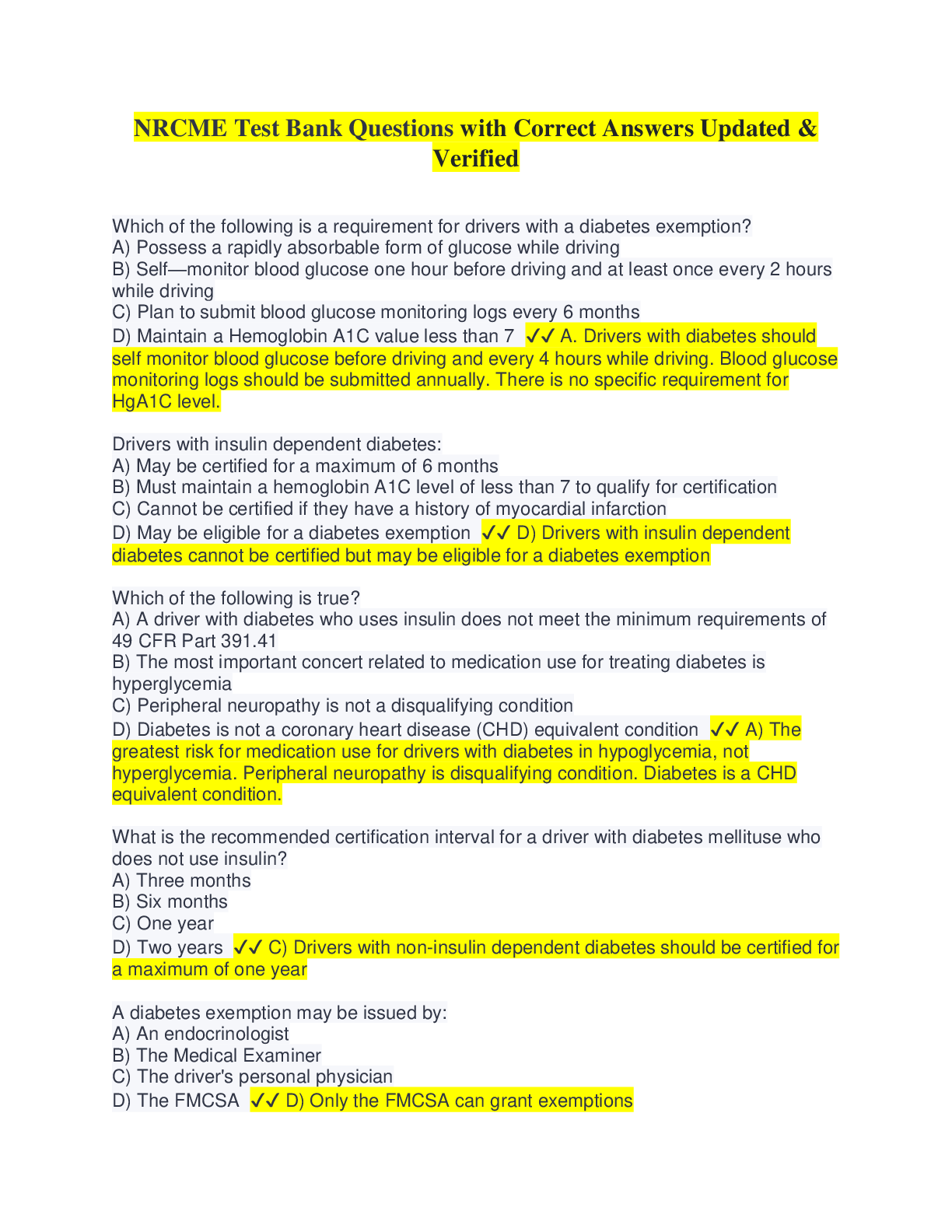
Buy this document to get the full access instantly
Instant Download Access after purchase
Buy NowInstant download
We Accept:

Reviews( 0 )
$12.00
Can't find what you want? Try our AI powered Search
Document information
Connected school, study & course
About the document
Uploaded On
Jan 05, 2023
Number of pages
37
Written in
Additional information
This document has been written for:
Uploaded
Jan 05, 2023
Downloads
0
Views
127
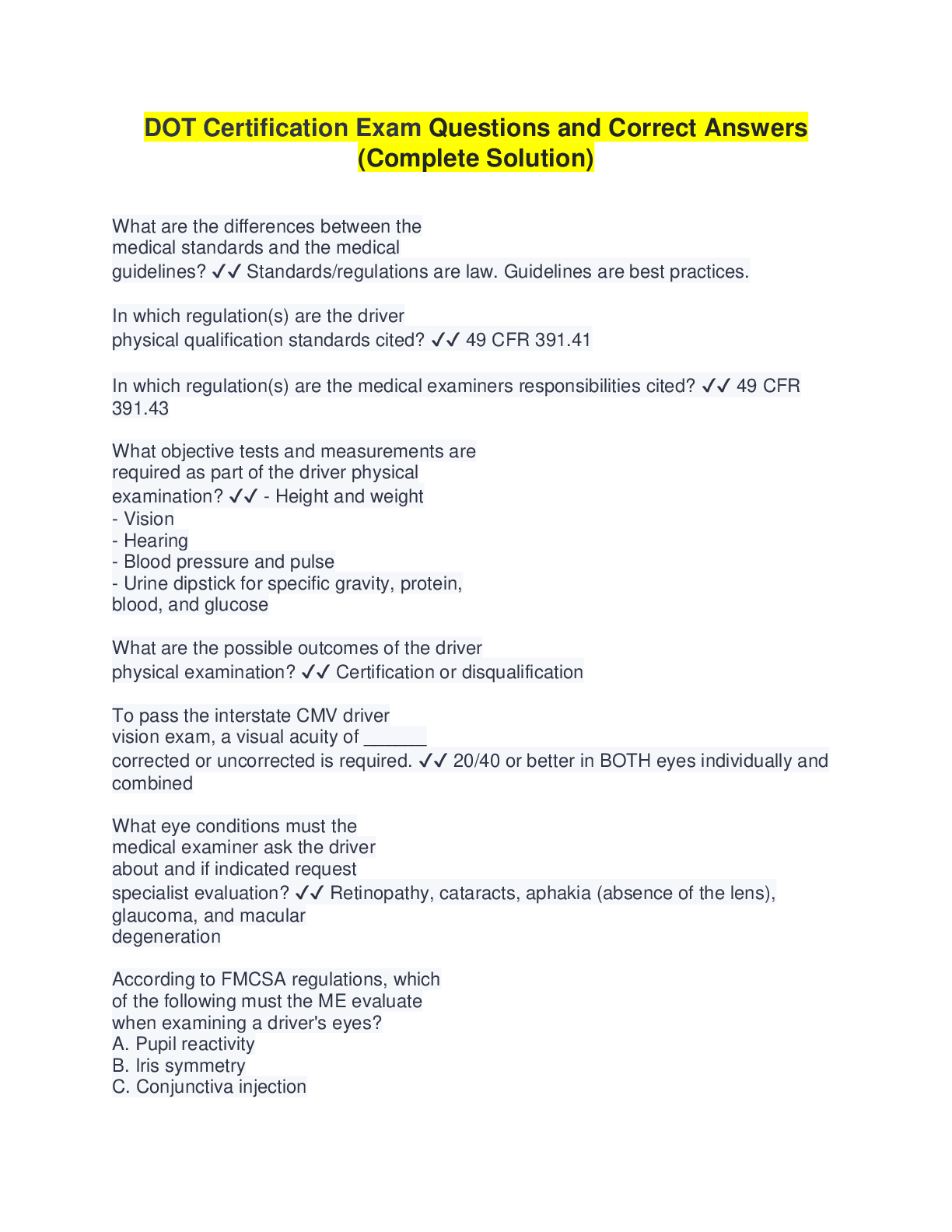


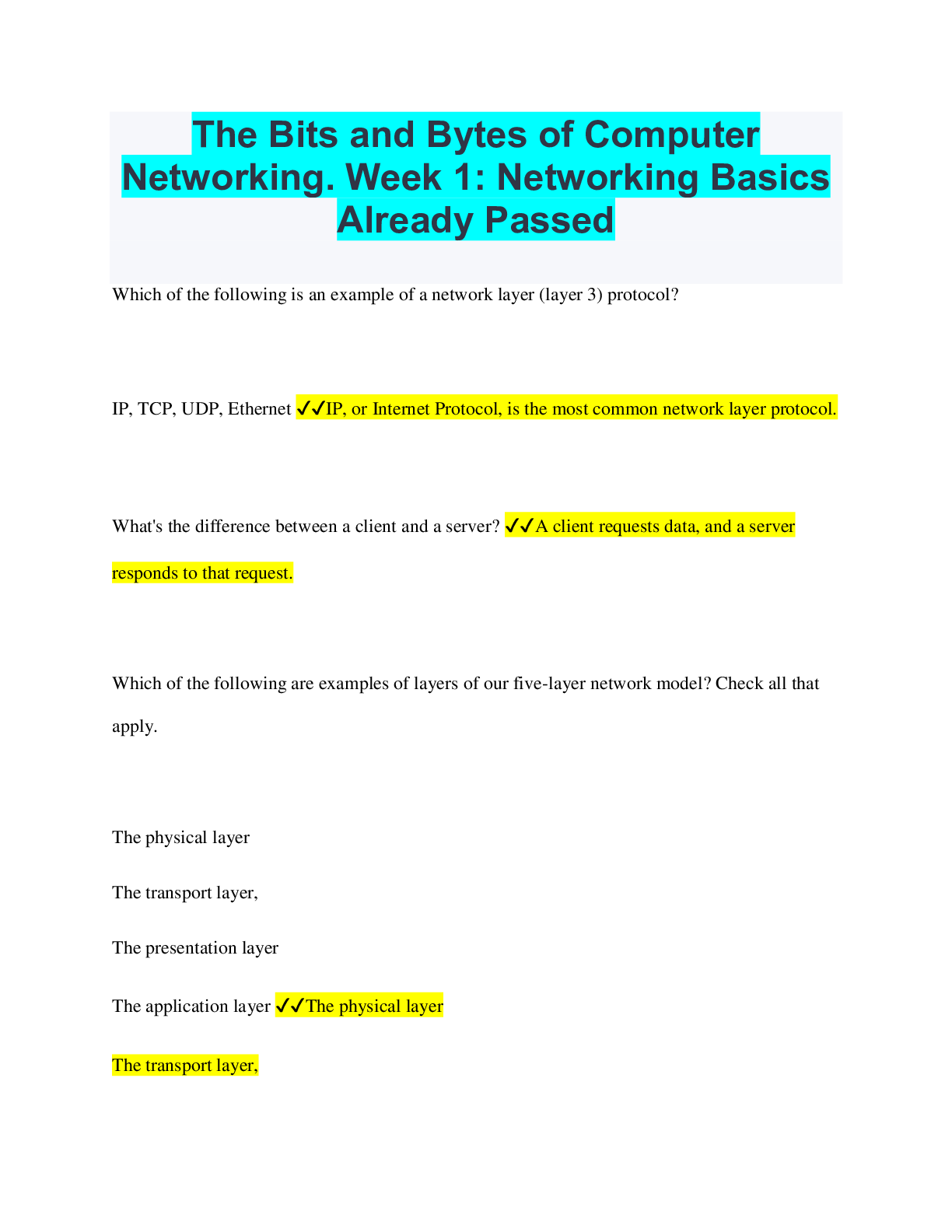
 Answered 2023.png)


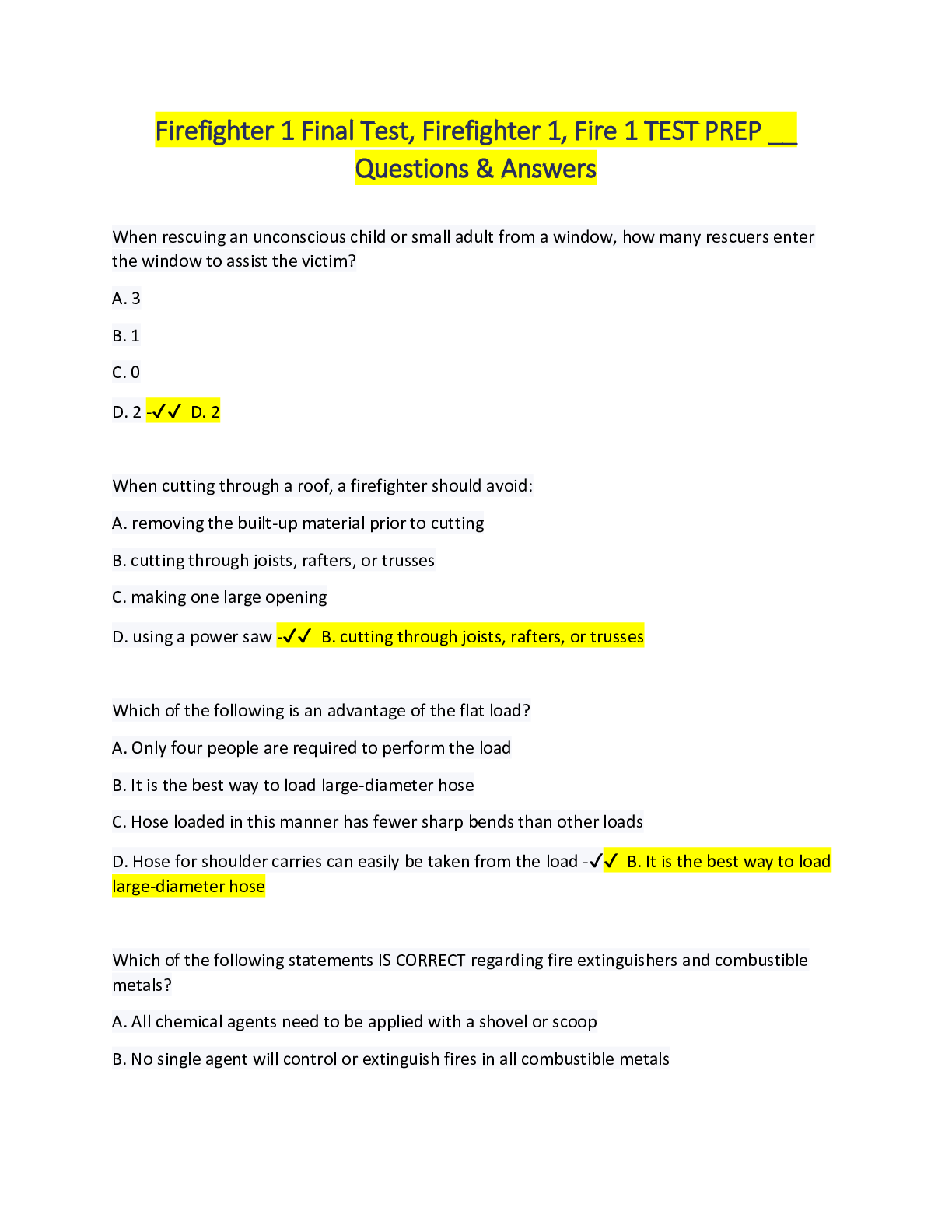
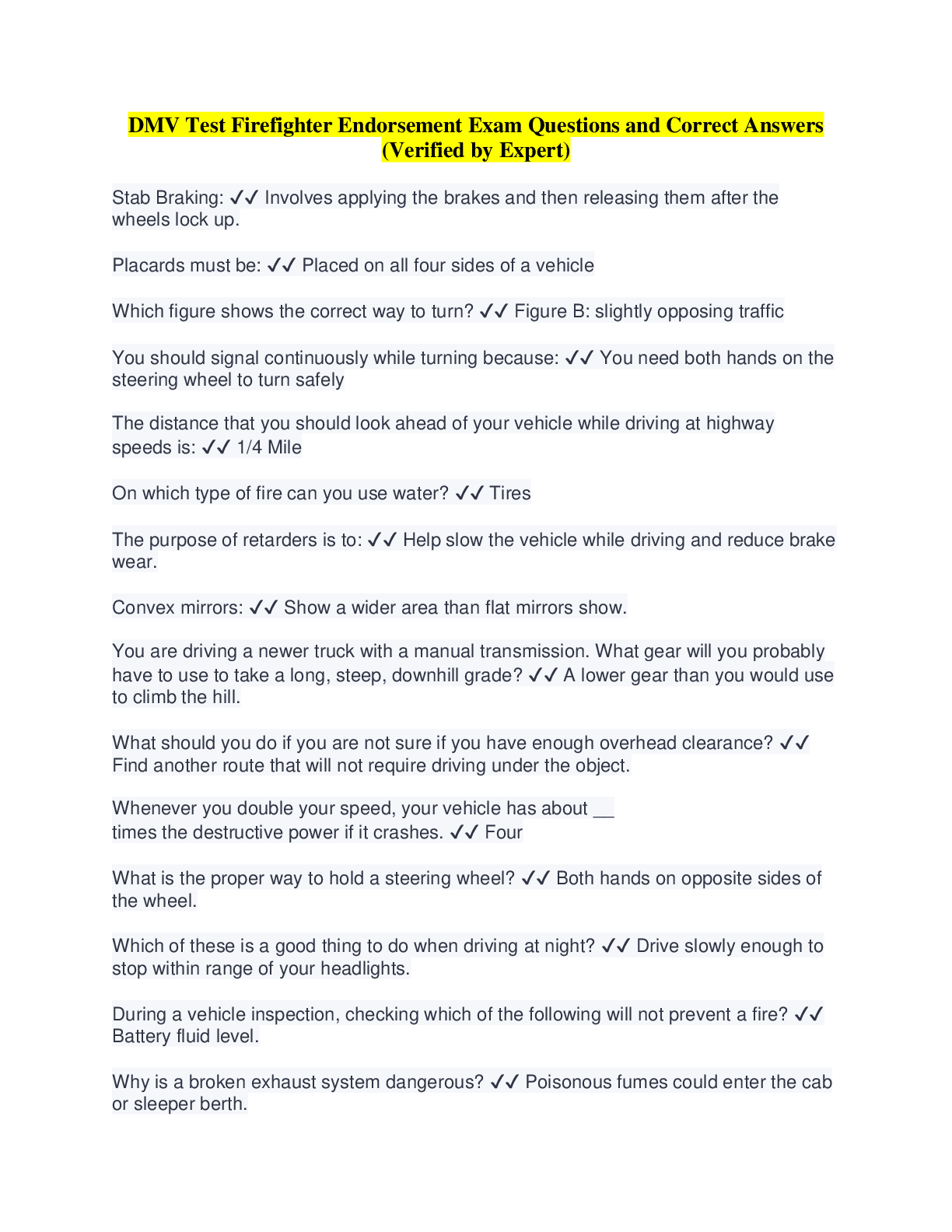


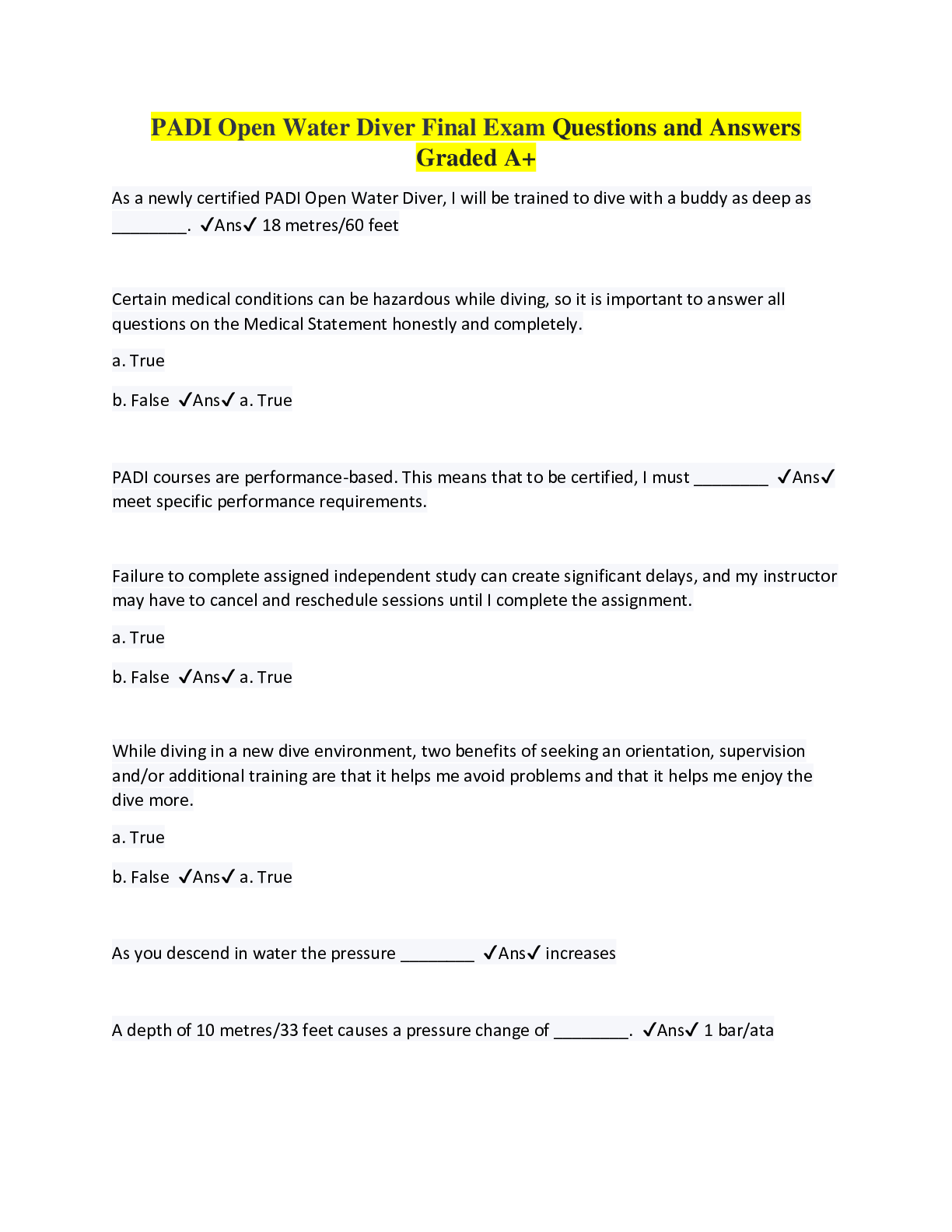

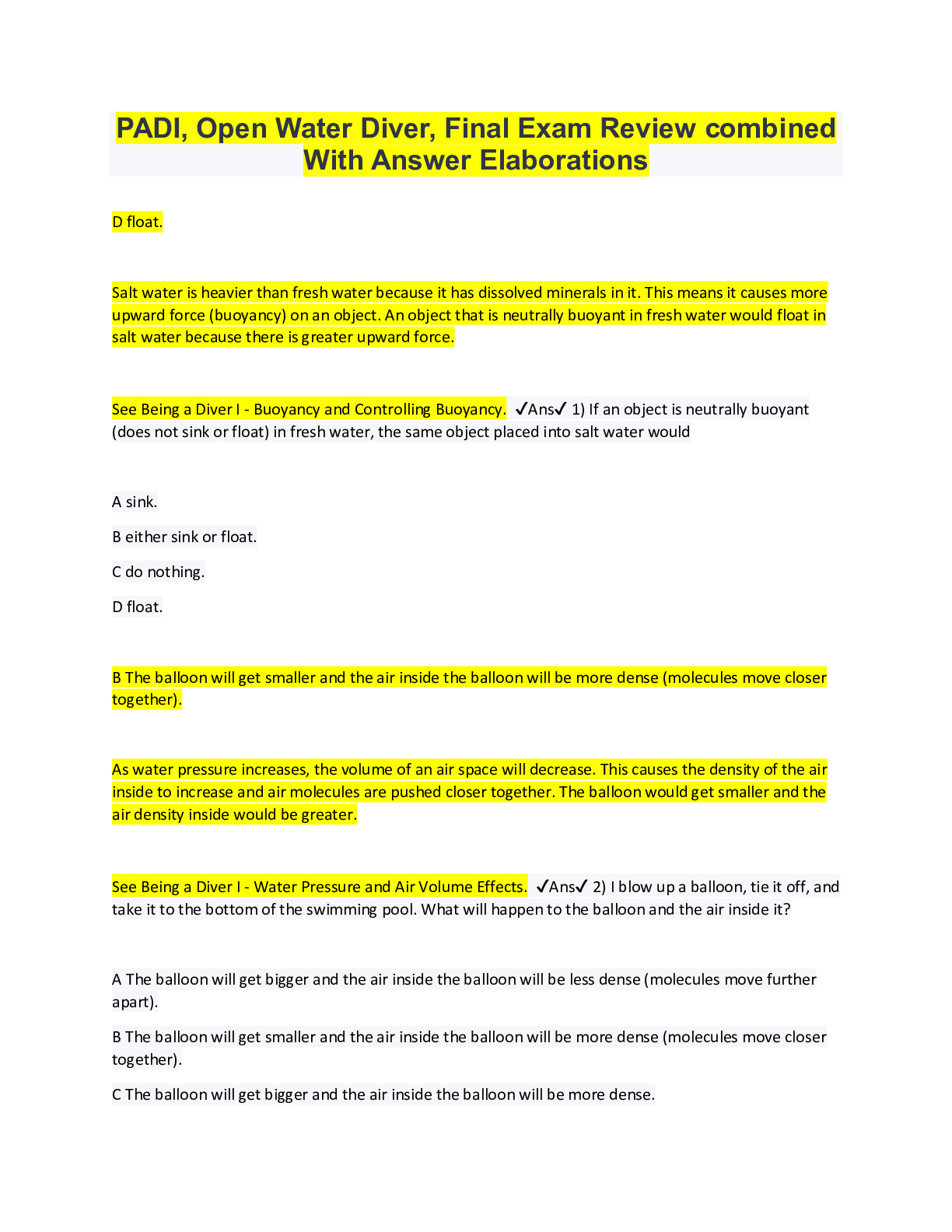
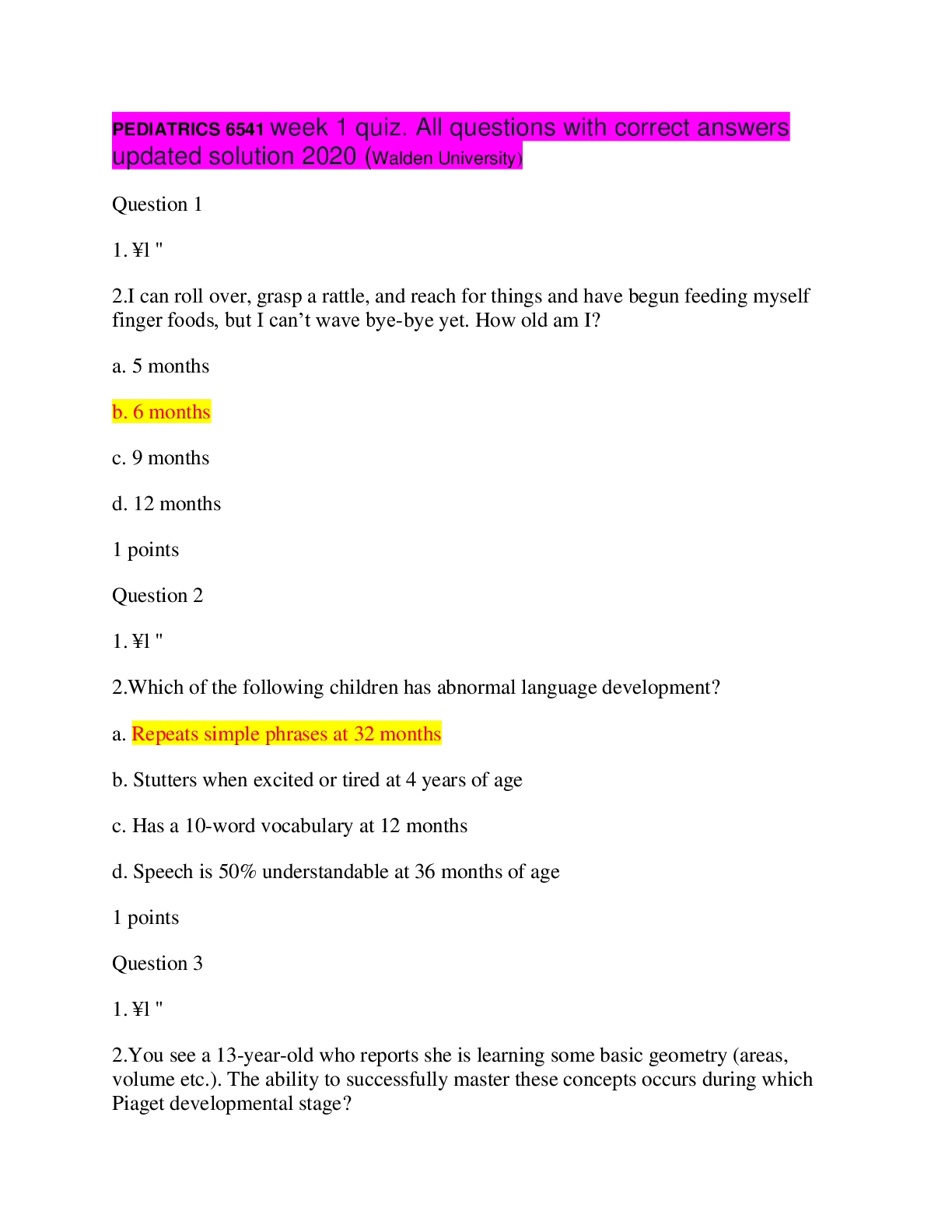

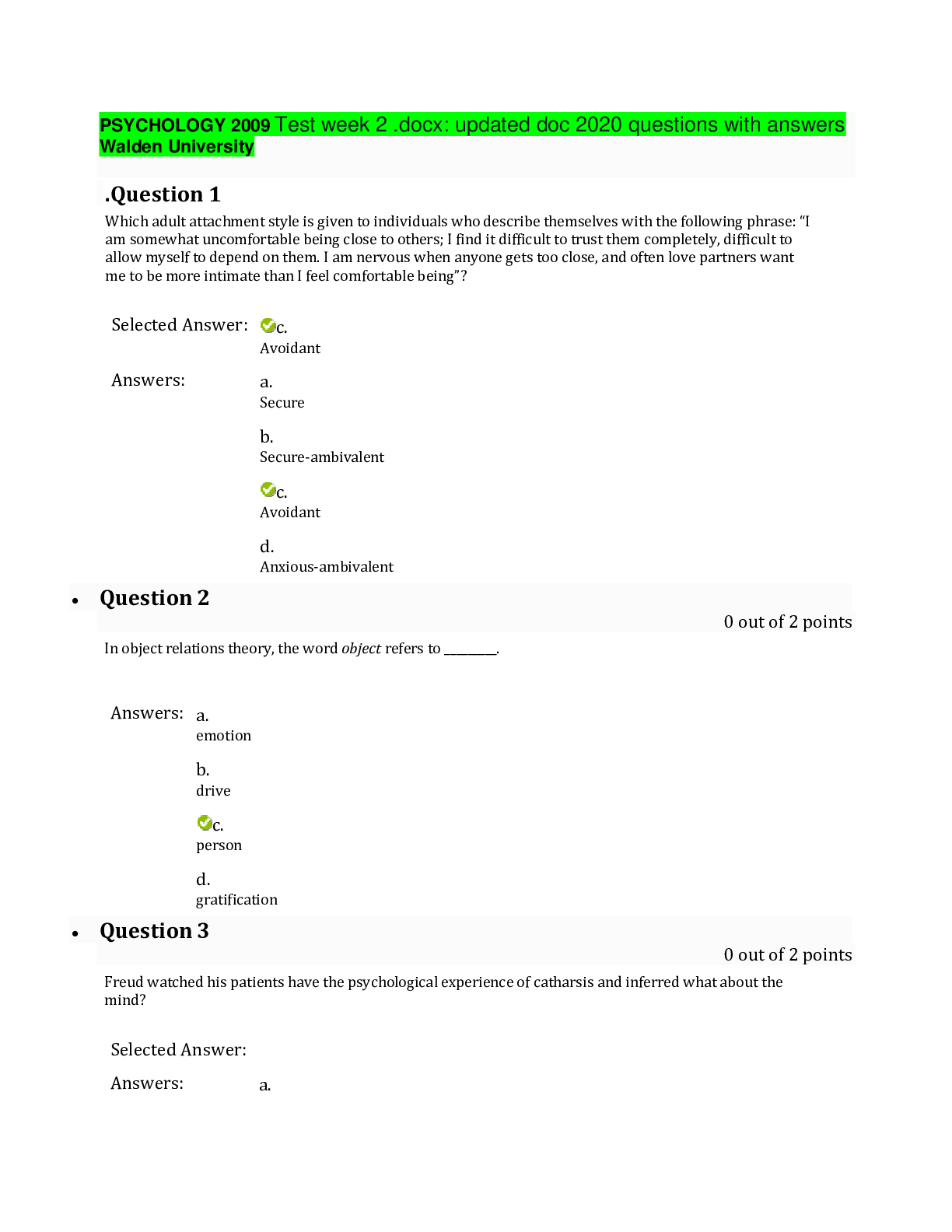

 answers.png)
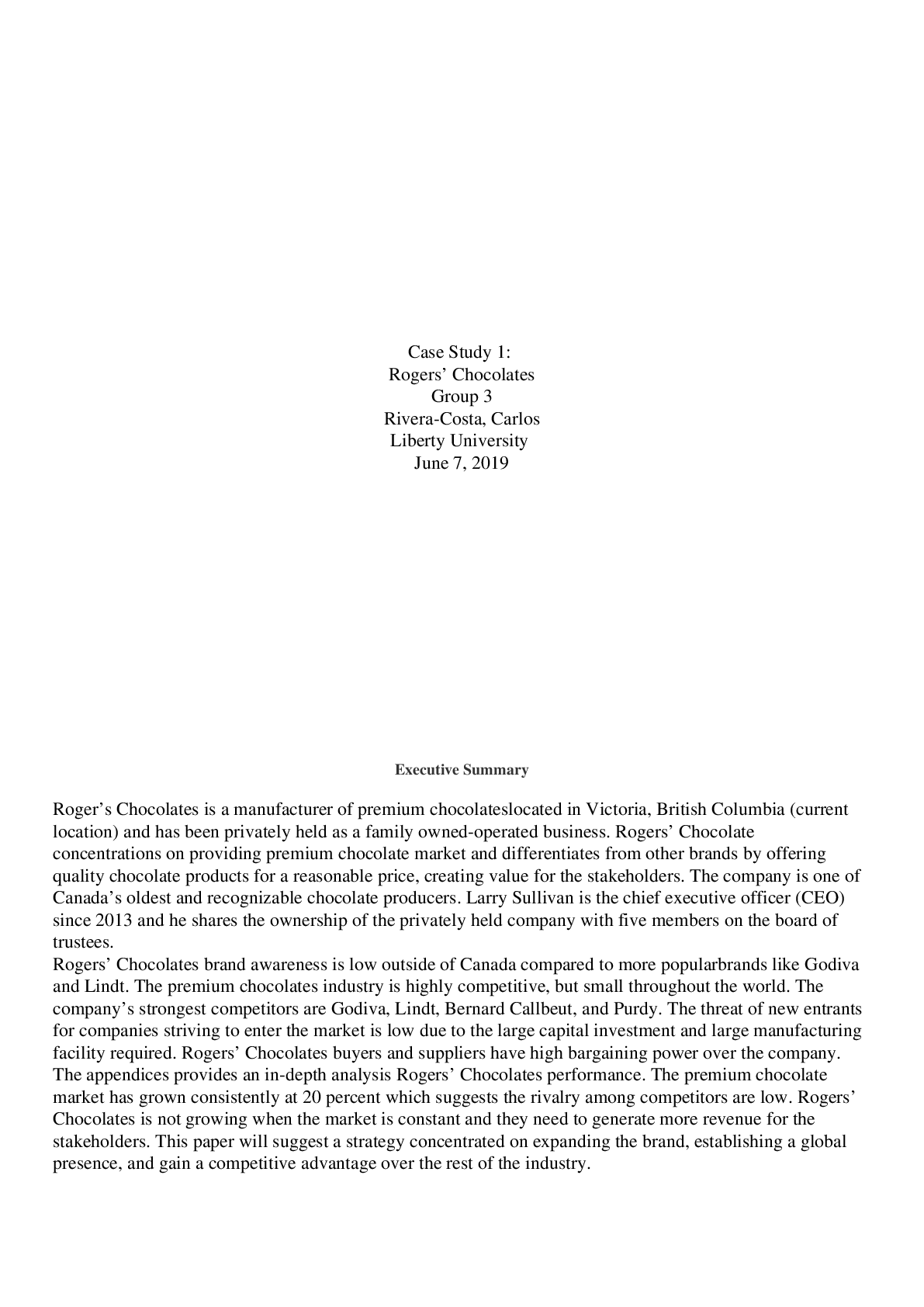

.png)





